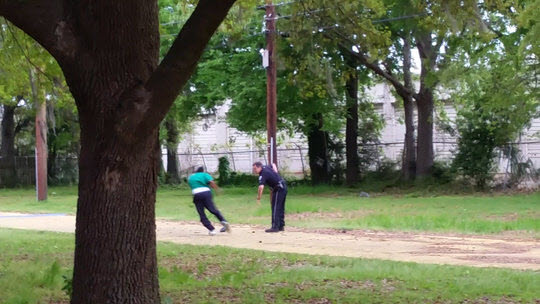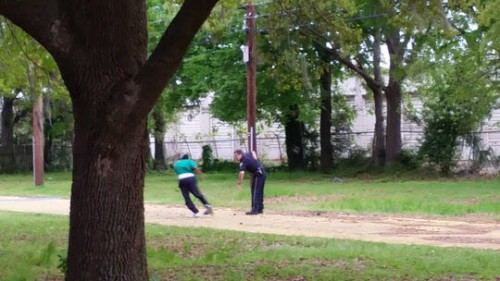
 By Dennis Parker
By Dennis Parker
Another unarmed black man is shot by a white police officer, this time in North Charleston, South Carolina, and we are again left wondering how it is that this can continue happening in this country with such heartbreaking regularity and what can we do to prevent future incidents. But mostly I am left wondering how long we can continue hearing these reports without confronting the tragic and uncomfortable racial truths which would be thrust front and center if only we had the integrity and courage to face them.
The police officer’s account of the incident is the familiar one of having to shoot in self-defense after 50-year-old Walter L. Scott, the man pulled over for a broken tail light, seized the officer’s Taser. The police reports also described efforts to administer CPR to Mr. Scott. And like so many other instances in which the fear of harm from African-American men approached for trivial offenses was seen as justification for their killing, the story might have ended there.
But this time there was a video taken by a fellow citizen which told a different and very chilling story. In the video, it is clear that Mr. Scott, who was running away from the officer, Michael T. Slager, presented no immediate threat to anybody when Slager squeezed off 8 shots directed at Mr. Scott’s back. Ultimately five bullets struck Mr. Scott, four hitting his back and one an ear. Lying face down on the grass, the only assistance Mr. Scott received after Officer Slager strolled over to his body was to place him in handcuffs before the officer ran back to the site of the original confrontation and returned to drop something by Mr. Scott’s side, presumably the Taser.
In announcing the officer’s arrest, the mayor of North Charleston, Keith Summey, stated that the law must be applied whether “you’re behind the shield or just a citizen on the street.” It’s a sentiment that should go without saying, but as evidenced by the difficulty in obtaining indictments against police officers in other videotaped killings, it is not one that has achieved acceptance in this country. And data out of South Carolina should only make the skepticism that justice will be done, prevalent among African-Americans, seem positively judicious.
According to an investigation conducted by South Carolina newspaper The State, police officers fired their weapons at 209 suspects, at least 79 of whom died, over the past five years. Where there was racial data available, the newspaper found that at least 101 of the suspects shot at were African-American in a state where blacks make up only 13 percent of the state’s population, according to U.S. Census Bureau data, while at least 67 of the suspects were white, who make up nearly 78 percent of the state’s population. Not one officer was convicted for discharging a weapon inappropriately.
If Officer Slager is convicted after receiving due process, this case will be described as evidence that the criminal justice system can work. But there are too many nagging questions that remain to rejoice in that presumptuous outcome. Why are the victims of such shootings and their families treated with so little respect and human dignity? Is this violence the result of aberrant acts committed by individuals? Or are they the inevitable result of a criminal justice and incarceration system infected by bias and discrimination at every stage from beginning to end? And, perhaps most pressingly, what would have happened had there been no video?
Certain responses to this most recent video are already being heard again. There have rightly been calls for increased recording of police-civilian interactions both by civilian bystanders and through the use of police body cameras. Calls for increased training have once again been made. These measures are likely to be of some assistance, but they ultimately are likely to be insufficient to address the deep structural and cultural problems that give rise to the situation we find ourselves in.
We should not have to rely on the fortuitous presence of bystanders with cell phones to prevent the use of illegal force by police. The fact that videotaping these encounters is legal is no guarantee of safety for a person seeking to record and preserve the interaction. Nor is the existence of a videotape a guarantee of accountability as evidenced by Eric Garner, placed in a fatal stranglehold during an investigation of the sale of loose cigarettes in Staten Island; Tamir Rice, the 12-year-old shot while playing with a toy gun in Cleveland; or John Crawford III, shot and killed in a Walmart near Dayton, Ohio, after picking up an air rifle off the shelf while speaking on a cell phone with his wife.
There is something fundamentally wrong when the police, whom we charge to enforce the law and grant the authority to make life and death decisions, must be videotaped in order to assure that they themselves comply with the law. One cannot help but wonder if these shootings would be so common if so many people did not believe, consciously or unconsciously, in the inherent dangerousness of black men. Or would there be more accountability if the majority of white Americans could even contemplate the possibility of a police officer’s bullet killing their child for playing with a toy gun in a park. Or would there be more outrage if they themselves could be shot down for picking up an air rifle offered for sale in a store.
The roots of the problem are far too deep to be solved by any technological or training solution, however necessary they are. Police officers are creations of the society they serve and protect. Until America faces up to this uncomfortable truth, we can fully expect to continue reading stories like this one out of South Carolina, video recording or no video recording.
Dennis Parker is Director of the ACLU Racial Justice Program
Once again I find my self opposing the view that this is all about race, although I agree race is often a factor. We do not have to wait for more stories of preventable deaths. We have another as reported by the Washington Post
http://www.washingtonpost.com/local/crime/fairfax-jail-inmate-who-died-was-fully-restrained-when-tasered-four-times/2015/04/11/ede0957c-decd-11e4-be40-566e2653afe5_story.html
In this instance we have a petite ( 130 lb), mentally ill, complete restrained including hands, feet and spit mask, woman whose crime was failure to sit down in a wheel chair for transport to a different facility when so ordered. For this she was tasered four times resulting in her death. She happened to be black. I have no idea of the race of the officers involved but to me it is irrelevant.
Ironically this woman’s last quoted words were “You promised you would not hurt me”.
The bigger issue in this instance and multiple other instances in prison cell extractions
( of which I hear from a first hand source) is police and corrections brutality. This is rarely based on fear as the inmates are often fully restrained or confined at the time. It is about frustration, anger, and ego on the part of the officers who become enraged when they are not immediately obeyed. It is about the perception that those who have found themselves on the wrong side of the bars whether convicted or not, are somehow inferior to the officers. I do not believe that these are the acts of “a few rogue cops”. At lunch one day with a group of prison corrections officials I was appalled by the degree of their contempt for and joking about ways to harm their prisoners and get away with it, including the use of tasers and shooting, all told as though “joking” but chilling all the same. I believe that what is necessary in police and corrections today is the same kind of transformation that has been occurring in the past 30 years in medicine. Just as doctors have needed to drop the pretense of being somehow god like or all knowing, police and corrections officers need to evolve past “the good guys vs the bad guys” mentality to get to the point where each individual is viewed as a human being worth of respect, not brutality applied to even the most helpless of their charges.
Race is a factor, but you’re correct, this is not just about race, a lot of it is about police tactics.
Not sure what tactic is in question when a traffic stop results in the person running twice?
Is it cultural? Do all Blacks run from authority figures? Seems like all wrongdoers run, or at least the ones on COPS.
As an abused child, I remember what talking back got me, and I never ran. I had to stand and take it. Maybe these runners feel the same fight or flight? I am looking for some reason other than race too. But if the whole race teaches their kids to be defiant and argumentative with parents and Police, then I can understand why this happens.
The Police feel they are in charge, always. When someone surrounds them with defiance and argument, they assert their authority, whatever it takes to get cooperation. That is more a parent child relationship, abusive maybe, but not peer to peer. Am I taking a stretch on this?
one of the key problems for police is how to handle people who are resisting or not cooperating but either not doing so violently or not a deadly threat to the officer or others. that is a key common denominator in a lot of these cases and the area where i think police tactics are wanting.
ironically i think uc davis may have come up with a good model for this. when the bank blockers happened, the tactic was obviously designed to force the police to arrest the protesters. instead, they documented the crime, took video, and mailed them notices to appear. suddenly the confrontation was gone and the protest movement collapsed.
so what happens if the police take a general approach – make the determination – is the person a threat to the public or the officer. and if not, and they resist, simply document the information, take it down, and have the da investigate and mail their summons to court later.
as much as i think the issue of race is intricately linked here, it becomes enough of a distraction that if you can address the issue without using race and approaching police tactics, it might be politically a better idea.